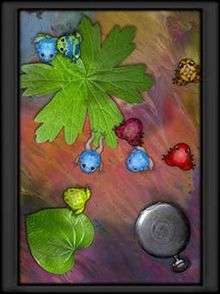Pocket Frogs
| Pocket Frogs | |
|---|---|
 The Pocket Frogs logo since version 2.0. | |
| Developer(s) | NimbleBit |
| Publisher(s) | NimbleBit |
| Platform(s) | iOS, Android |
| Release date(s) | September 15, 2010 |
| Genre(s) | Simulation |
| Mode(s) | Multiplayer video game, Single-player video game |
Pocket Frogs is a life simulation video game developed and published by NimbleBit for the iOS App Store and Google Play Store. It was released as a free game with additional in-app purchases. The aim is to complete the 'Froggydex' by earning money to breed and sell fictitious frogs.[1][2]
Gameplay

When the game begins, the player owns two frogs, a Cocos Bruna Anura and a Green Folium Anura, one regular habitat, a nursery habitat, and 1000 coins. In the pond view, players control their frog, eating flies to tame it, which makes it happy, breeding with other frogs players find, and finding presents. Presents include various breeds of frogs, potions (for quick frog growths and races), stamps (for quick delivery of mailbox items) and coins (which are used to order frogs in the Froggydex, Catalog, or FrogMart, and to order sceneries or habitat backgrounds from the Supply Shop). The potions and stamp count are located in upper left corner of the screen, the XP is located in the upper right corner of the screen, the coin count is located at the lower left corner of the screen, and the back/menu button is located at the lower right corner of the screen.

Besides taming the frog, eating flies increases their happiness and, if they are not yet mature, can lessen the time left to maturation. The size of the flies vary and the bigger the fly the happier the frog. The biggest of the flies also add to the player's current XP points. The player receives approximately 10% of the frog’s value in experience points when they are tamed and it takes 3x the rarity of the frog in flies to tame them. Frogs can also be gifted via Game Center.[3][4][5][6] The game is set in real time, which means that it may take up to 2 days for a frog to hatch and grow into an adult. The player levels up by earning a set amount of XP which increases with every level. To level up the player needs to get the required number of XP, or experience points, located in the top right corner during game play, to automatically level up to the next level. The highest level is 115, at which the player's score to level up becomes negative one even though the player has passed to a number.
Every week in the Weekly Sets, the player has to own all the frogs needed in the Weekly Sets. If the player decides to see the newest weekly set, the old one is lost, until the player has done all the sets newer sets. The player gets rewarded potions and stamps for every weekly set done.
Missions require a specific type of frog to get a reward of coins, potions or stamps.
Species
Species of frog are sorted out by name from their main colour (for example: Blue), then their subsidiary colour (for example: Cafea - meaning coffee-bean-coloured), and then the species's name. For example, a Green Folium Anura (a mainly green, green-subsidiary frog with cheek blushes as the subsidiary pattern), a Blue Aurum Zebrae (a mainly blue, yellow-subsidiary frog with a zebra pattern as its subsidiary pattern) or a Cocos Tingo Symphonia (a mainly brown, red-subsidiary frog with a music note on its back as the subsidiary pattern).
Available frogs during each level
|
|
|
|
Level 1-4 frogs are labeled as "common", level 5-8 frogs are labeled as "rare", level 9-12 frogs are labeled as "endangered" frogs, and level 13-32 frogs are labeled as "legendary" frogs.
History
In Version 1.2, on July 12, 2011, new species Bulbus, Trivium, Geminus, Orbis, Signum, Gyrus, Vinaceus, Persona, Bulla, and Obaro were added into the Froggydex.
Until Version 2.0, on 1 November 2012, there were only frog species up to Level 16.[7] Plus+ Network was removed in the same update. The only way to trade frogs from then on was to use Game Center.
On September 24, 2015, Android version of Pocket Frogs which was ported by Mobage was removed because Mobage had removed their game servers and also other games like Pocket Planes and Tiny Tower. There are no plans for porting it from Apple Store and re-releasing it and the data from Android cannot be transferred to iOS. Nimblebit announced that future sequels or major update may re-releasing the game into Android.[8][9]
See also
References
- ↑ "Pocket frogs on app store". Itunes.apple.com. 2013-05-16. Retrieved 2013-08-09.
- ↑ "Pocket Frogs on appshopper". Appshopper.com. 2013-05-16. Retrieved 2013-08-09.
- ↑ "Touch Arcade Review". Toucharcade.com. 2010-09-14. Retrieved 2013-08-09.
- ↑ "148 apps review". 148apps.com. 2010-09-15. Retrieved 2013-08-09.
- ↑ Rattray, Tim (2010-09-14). "Slide to play review". Slidetoplay.com. Retrieved 2013-08-09.
- ↑ "Tapscape review". Tapscape.com. Retrieved 2013-08-09.
- ↑ "Pocket Frogs Guide - iPhone, iPad, iPod Touch, Android". Thonky.com. Retrieved 2014-06-29.
- ↑ http://support.nimblebit.com/customer/en/portal/articles/2103500-android-version-shutdown
- ↑ http://support.nimblebit.com/customer/en/portal/articles/2215443-where-did-pocket-planes-for-android-go-